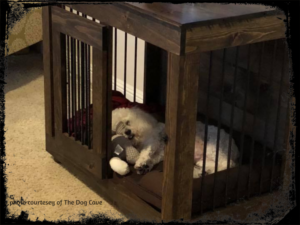Make the Crate Great: Tips for Success in Crate Training Your Dog
Bringing home a new puppy or dog and wondering how to teach them the house rules?
Crate training can be a great way to deal with common issues such as housebreaking, hyperactivity, separation anxiety, or destructive behaviors – provided you use positive techniques.
Dogs are den animals, and wild dogs use their den as a place to sleep and feel safe. Your pup will come to regard their crate as their den, where they can feel comfortable and secure. Because dogs don’t like to soil their sleeping areas, crates can be a valuable tool for housebreaking. It also can limit access to other parts of the house while they learn other rules, such as not chewing on things other tha their toys.
A Word of Caution
Crates should never be used as punishment, nor should your dog be left in them all day and night. Puppies six months of age or younger should not be confined to a crate for more than three or four hours at a time. Generally speaking, a puppy can control their bladder for one hour to every month of age. A puppy or dog trying to “hold it” by being left in a crate too long may develop bladder infections. This is also true for adult dogs who are being housetrained – although they are physically able to control their bladder and bowels, they just don’t yet understand that they need to eliminate outside.
What Kind of Crate?
A crate should be large enough for your dog to stand and turn around comfortably. If you have a puppy, buy a crate large enough for them to use as an adult, and block off part of the crate so they can’t eliminate at one end and sit or sleep at the other.
While fabric crates are great for travel since they are lightweight and easy to fold, you should opt for a wire or plastic crate for training purposes. Both are more secure and easy to clean while making it more difficult for clever dogs to escape. If you don’t like the look of metal and plastic crates, you can always look for more artistically designed wooden crates, such as those available through The Dog Cave, o are designed to look more like furniture.
Crate Training 101
Here are some tips to make the crate training process go smoothly for both you and your pet:
- Initially place the crate in a space where you or your family spends time. Place a soft blanket or towel inside the crate, and leave the door open so your dog can explore at their own pace.
- If your dog doesn’t seem interested in the crate, drop some treats nearby and, in a pleasant tone of voice, encourage them to come closer. Then drop some treats just inside the crate’s entrance, and gradually drop them toward the rear of the crate.
- When your dog is comfortable going into the crate to get treats, begin feeding them their regular means inside the crate, gradually moving the dish toward the back of the crate. Eventually, you will be able to close the door while they are eating. As soon as they finish eating, open the door. You can then gradually begin increasing the time they stay in the crate.
- You then will be able to leave your pup in the crate for short periods of time while you are at home. Give them a command, such as “kennel,” and encourage them to enter the crate. After you’ve closed the door, sit near the crate for a few minutes, then move into another room for a few minutes. Come back in, wait a few minutes, and then let them out of the crate. Gradually increase the length of time you leave them crated and the time you are out of sight. When your pet can stay in the crate quietly for 30 minutes or so, you will be able to leave them there for a short time while you run errands or letting them sleep in their crate overnight. This is an especially important step for dogs who are suffering from separation anxiety.
With patience and support, crate training can be a great experience for you and your dog!








